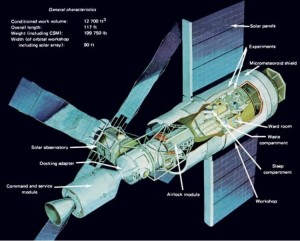 When most of us think of a space station, we think of the International Space Station that exists today, but in reality, that is not the first space station that ever floated above our atmosphere. The first one was a small space station called Skylab 1, The idea of a space station and crew to live and work in space was one that was tossed around for years. It was finally realized and launched into space on May 14, 1973, but this was not to be a mission without any issues.
When most of us think of a space station, we think of the International Space Station that exists today, but in reality, that is not the first space station that ever floated above our atmosphere. The first one was a small space station called Skylab 1, The idea of a space station and crew to live and work in space was one that was tossed around for years. It was finally realized and launched into space on May 14, 1973, but this was not to be a mission without any issues.
Just 63 seconds into the launch, a meteoroid shield that was supposed to shelter Skylab accidentally opened. This put Skylab 1 at serious risk. Later the facility experienced communications problems with the antenna as a direct result of the launch incident. Nevertheless, as problems go, this was the least of the agency’s worries. “When the meteoroid shield ripped loose, it disturbed the mounting of workshop solar array wing No. 2 and caused it to partially deploy. The exhaust plume of the second stage retro-rockets impacted the partially deployed solar array and literally blew it into space,” NASA wrote.
NASA scrambled to stabilize the space station and take necessary measures to minimize the posibility of overheating, as well as, figuring out a way to handle its reduced power situation. The first crew, which was led by Apollo 12 commander Pete Conrad, would need to make the station habitable before they could get to work. The crew’s first job, which took place during the spacewalk, just hours after launch, was to deploy the solar array, but that didn’t work, because the metal strip holding it is place, refused to release. The crews continued to be frustrated with this and other operations problems, before finally managing to make the space station work relatively well.
Skylab spent six years orbiting Earth until its decaying orbit caused it to re-enter the atmosphere. It scattered debris over the Indian Ocean and sparsely settled areas of Western Australia. In all, three crews successfully lived on board the station for several months each. The last crew spent 84 days in orbit. This was an an American record that stood until the shuttle era.
I’m sure that, looking back on those years now, NASA must have felt like it had been living in the stone age. With the Space Shuttle and the International Space Station, going into space in earlier days was rather archaic. Of course, with the end of the Space Shuttle era, we don’t know what the face of space travel will be in the  future. Only time will tell. Nevertheless, in 1973, we were well ahead of the rest of the world with the first space station, no matter how archaic it was.
future. Only time will tell. Nevertheless, in 1973, we were well ahead of the rest of the world with the first space station, no matter how archaic it was.
Because of multiple problems experienced by Skylab 1, the space station’s orbit decayed faster than expected. This was mostly due to intense solar activity heating up Earth’s atmosphere. Soon, NASA knew that it was inevitable that the space station would come down. They adjusted the station as much as possible so it wouldn’t hit populated areas upon re-entering on July 11, 1979. A slight mathmatical error led to pieces falling in Australia, but fortunately nobody was hurt, and thankfully that was not the end of the space stations.


Leave a Reply